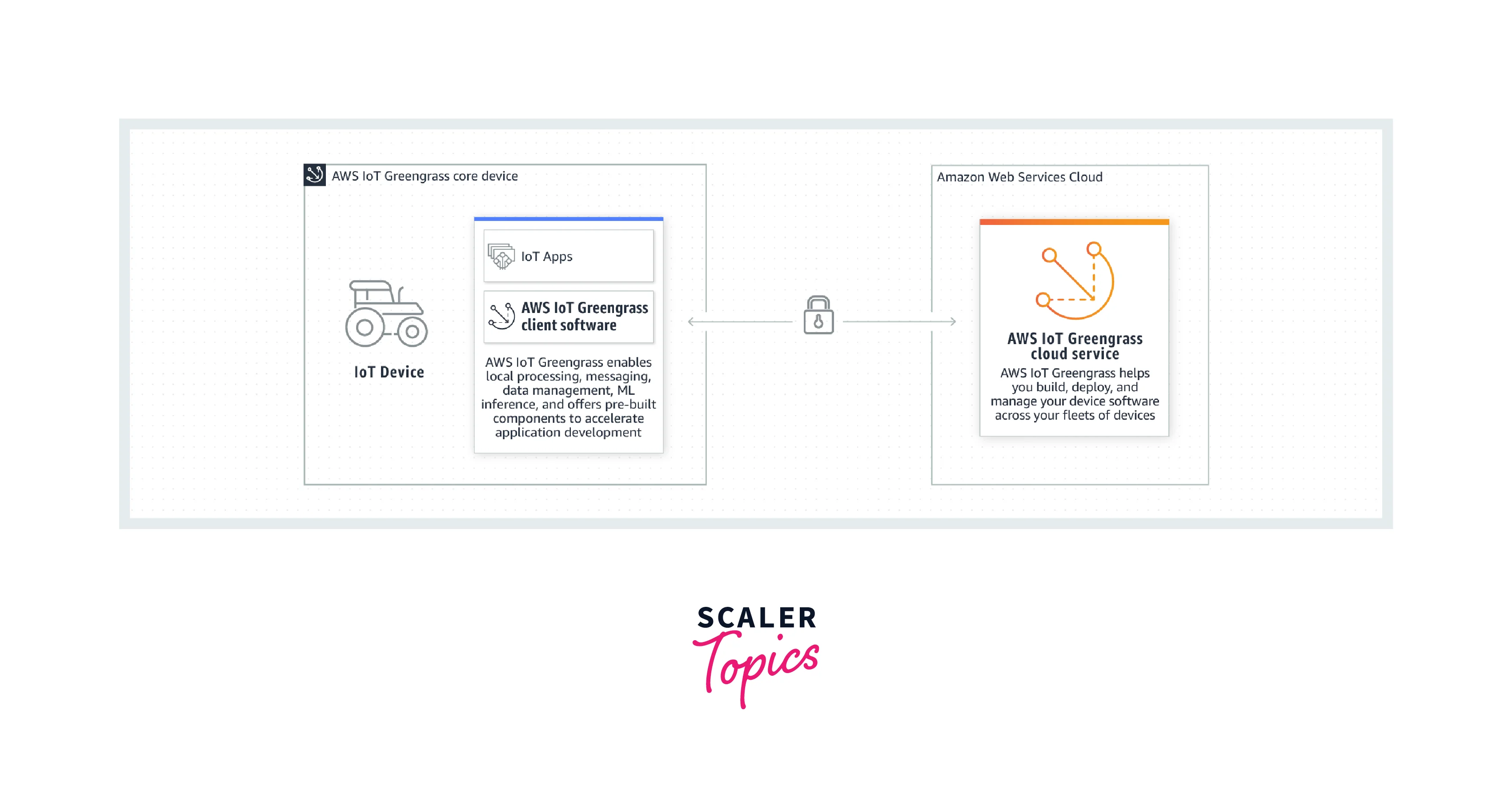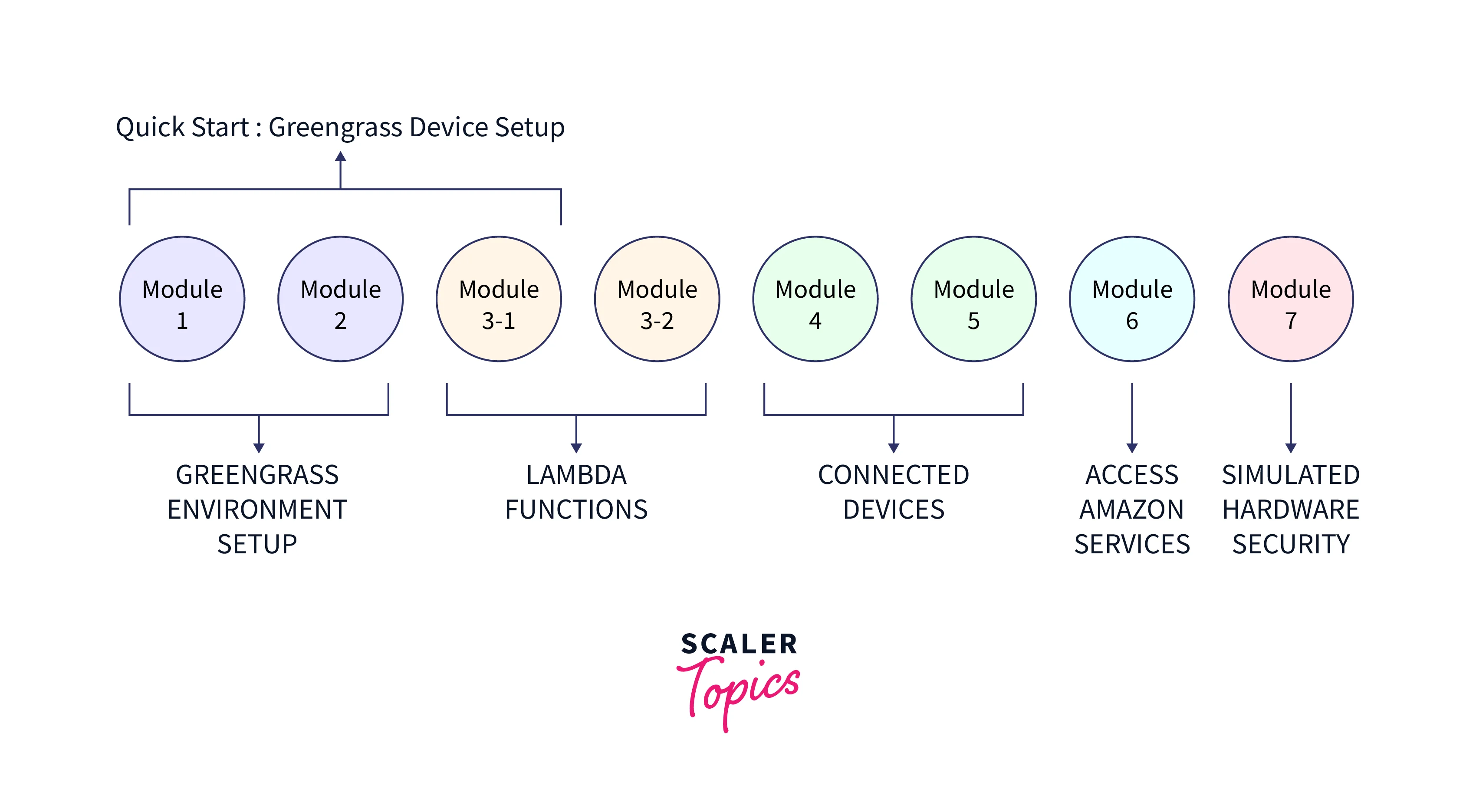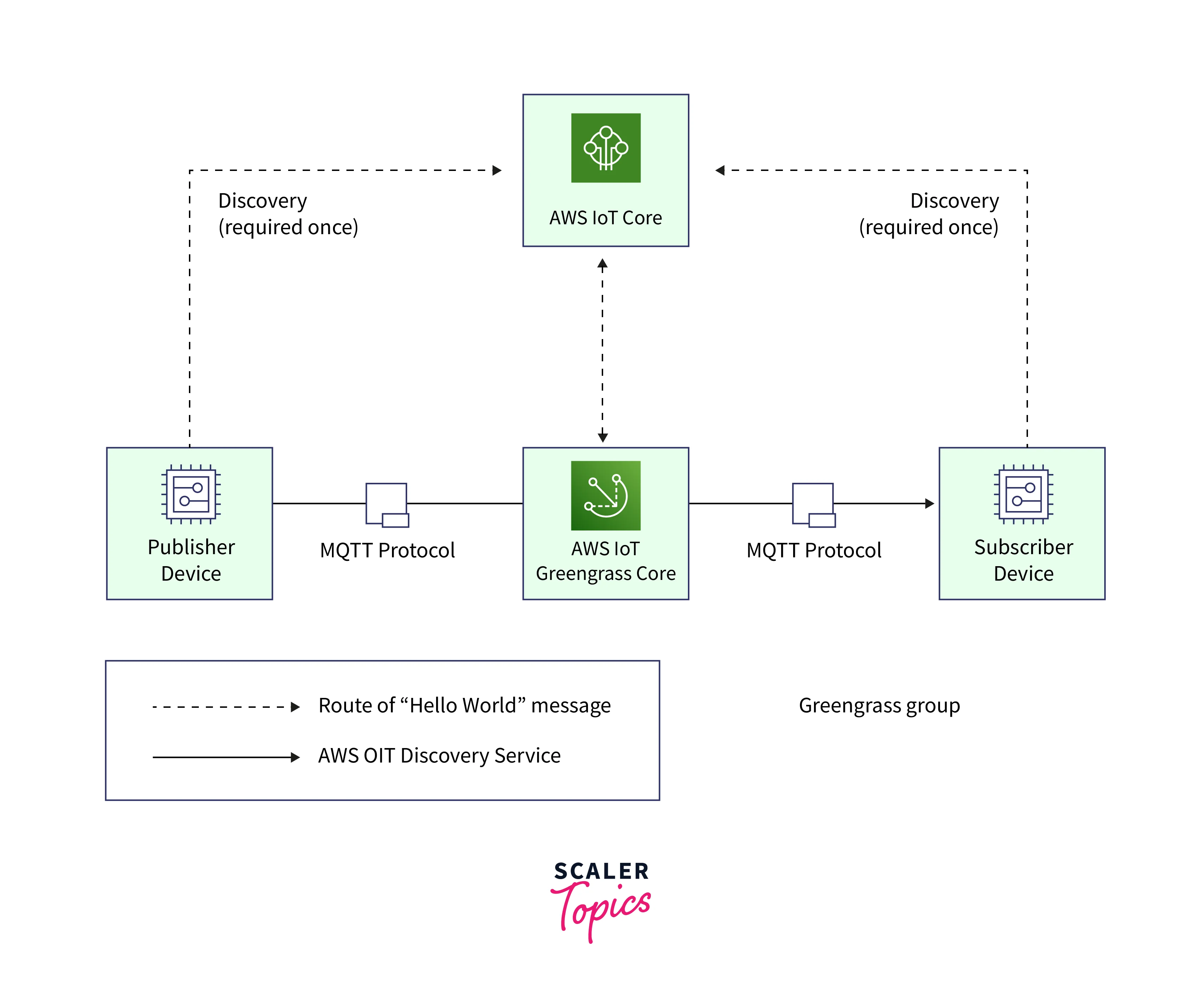AWS IoT Greengrass
Overview
AWS Greengrass is a service that provides Amazon Web Services capabilities to the Internet of Things (IoT) devices, enabling a company to gather and analyze data near the source. Greengrass systems, authorizations, apps, and notifications from the AWS public cloud are defined and configured by an Information Technology team.
A programmer can create and install AWS Lambda features for Greengrass. While information from activities or cloud texts is obtained, these Lambda functions are executed locally on Greengrass apps. Greengrass safeguards information at the networks and device levels using verification and authorization.
What is AWS IoT Greengrass?
Amazon IoT Greengrass is an application that connects localized devices with the cloud. This allows computers to gather and evaluate information near the source of data, respond independently to local events, and interact safely on local networks. Local devices may also interconnect with AWS IoT Core and send IoT data to the AWS Cloud. AWS IoT Greengrass developers may design serverless apps that are distributed to a device for local implementation using Amazon AWS lambda functions and preconfigured connections.
How Does It Work?
Amazon IoT Greengrass expands AWS to edge devices, allowing them to act directly on data generated while still utilizing the cloud platform for backups, control, and data analysis. Greengrass supports local device communication over the MQTT(MQ Telemetry Transport) protocol, enabling a direct channel to the cloud. The AWS IoT subsequently connects devices to the AWS Greengrass Core. You may use AWS IoT Greengrass to restrict data sources but only enable required data to be communicated back to the AWS cloud.

AWS IoT Greengrass enables companies to create IoT devices and application programming logic. Amazon IoT Greengrass, in particular, offers cloud-based governance of software architecture that keeps running on machines. Local Lambda operations and gateways are activated by local events, cloud communications, or other resources.
Features of AWS Greengrass
-
Processing for AWS Lambda Functions Users may execute AWS Lambda functions on the devices to reply fast, engage with others, and analyze data to reduce the expense of sending data to the cloud.
-
Docker Container Support Docker containers may be deployed, executed, and managed using AWS IoT Greengrass devices. Docker container registries, such as Amazon Elastic Container Registry (Amazon ECR), Docker Hub, or private Docker Trusted Registries, may store your Docker image.
-
Device Shadows are Supported AWS IoT Greengrass also provides the AWS IoT Device Shadows feature. The Device Shadow stores the product's state, acting as a "shadow" or "virtual version" of each item, tracking the product's present vs. ideal state.
-
Access to local resources Local resources associated with the device can be accessed by AWS Lambda functions installed on an AWS IoT Greengrass Core. This enables you to easily access and handle local data by using sensors, GPUs, serial ports, local file systems, or other devices for security purposes.
-
Local Improvement It enables you to swiftly write and test code on a testing machine before deploying it to your operational devices through the AWS cloud. The Command Line Interface (CLI) may be used to natively build and test apps on your device, and the native debug console can assist users in visibly debugging programs.
-
ML Inference Greengrass AWS IoT ML Inference is a capability that enables machine learning inference to be performed natively on AWS IoT Greengrass devices utilizing models developed and trained in the AWS cloud. This implies that for apps that employ ML inference, you will not pay data transport charges or additional latencies.
-
Greengrass Stream Manager IoT Greengrass is used to collect, analyze, and transmit data streams from IoT systems, as well as control the data's cycle time on devices to save production time. It offers a standard system for processing data streams, managing local data retention regulations, and transmitting metadata.
-
Greengrass Components It has prebuilt features for typical use applications, allowing users to identify, import, set up, and launch apps and services just at the edges without having to learn multiple device protocols, maintain passwords, or interface with outside APIs. You may also build your custom modules or just reuse standard business functionality from one device to the next.
AWS IoT Greengrass Core Software
The two main software products for AWS Greengrass are AWS Greengrass Core and AWS IoT Device Software Development Kit (SDK). A Greengrass Group is formed when devices running AWS Greengrass Core and the AWS IoT Device SDK connect.
Each Greengrass Group needs AWS Greengrass Core software, which enables the local implementation of Lambda-based applications. Core operates on a physical machine that needs 1 GHz of computational resources, 128MB of Main memory, and a CPU capable of supporting an operating system such as Windows. Greengrass Core also enables a team to leverage what AWS refers to as device shadows to control the installation and record the current statuses of IoT devices. AWS Greengrass Core supports local device communications via the MQTT protocol and secure connectivity to the cloud.
The AWS IoT Device SDK allows devices to communicate with the AWS Greengrass Core. The AWS IoT Device SDK for Greengrass supports C++ and may operate on every device that has Transport Layer Security support.
AWS IoT Greengrass ML Inference
AWS IoT Greengrass enables machine learning inference to be performed natively on devices using models developed, validated, and enhanced in the AWS cloud. AWS IoT Greengrass makes it possible to use ML models developed in AWS SageMaker or your pre-trained model saved in AWS Simple Storage Service.
Machine learning data analysis is the process algorithms that are trained from available data (a process known as training) to make that choice about new data (a process known as inference). Patterns and correlations in the data are recognized during training to develop a model. The model enables a machine to make intelligent judgments on data that it has never seen before. Model optimization reduces the size of the model, allowing it to run faster. Training and improving machine learning models need huge computational resources, making the cloud an obvious choice. However, inference requires far fewer computational resources and is frequently performed in real-time as fresh data becomes available. It is critical to obtain inference findings with very low latency to ensure that your IoT applications can respond promptly to upcoming events.
ML models are constructed, analyzed, and improved in the cloud, and inference is performed locally on machines. For instance, you may use SageMaker to create a prediction model for image recognition, optimize it to operate on any video, and then install it to forecast unusual activity and deliver an alarm. Data collected through AWS IoT Greengrass inference may be given back to SageMaker, where it will be labeled and utilized to continually enhance the quality of ML models.
AWS Greengrass Use Cases
-
Run Along the Edge Amazon Web Services IoT Greengrass makes it simple to add intelligence to edge devices, such as those used for precision farming (or) driverless vehicles.
-
App Management Use any language, package methodology (or) runtime to deploy new or existing programs across fleets.
-
Manage Fleets Using MQTT and other protocols, users can manage and run device fleets in the field locally (or) remotely.
-
Handle Locally Locally collect, aggregate, filter, and transfer data. Manage and regulate which data is sent to the cloud for analytics and storage.
-
Industrial Predictive Maintenance Manufacturers are searching for fresh ways to assist boost operating efficiency on manufacturing floors as pricing pressure intensifies.
-
Security Manufacturers of security cameras are looking for new methods to make their products more intelligent and automate their danger-detecting capabilities. AWS IoT Greengrass can assist security cameras in increasing their capabilities.
-
Hospitality and Retail Retailers, cruise lines, and amusement parks are putting money into IoT apps to improve customer experience. For example, amusement parks can employ object detection models to keep track of visitor counts.
-
Video Processing AWS IoT Greengrass may be installed on devices connected to assist in making the local prediction. You may run and install ML models such as face recognition, object recognition, and picture densities right on the device using AWS IoT Greengrass.
AWS Greengrass Pricing
Users just need to pay for what they use resources AWS IoT Greengrass. The number of Core devices linked to the Greengrass cloud service monthly will be invoiced to users.
AWS IoT Greengrass comes with two customer programs:
-
AWS Greengrass Core: A runtime that supports Lambda functions, communications, devices shadows, and authentication.
-
SDK for AWS IoT Devices: Allows devices to link to AWS IoT Greengrass Core through a local area network.
Free Tier on AWS For one year, the AWS Free Tier covers the very first three AWS IoT Greengrass Core devices that are connected monthly.
The free tier usage is computed and added to the bill monthly throughout all AWS Regions except for the AWS GovCloud Region; leftover monthly consumption does not carry over.
Additional Fees AWS IoT Greengrass establishes one or more connections to AWS IoT Core to allow deployment, device shadowing, and message transmission activities. When an internet connection is available, these connections are immediately formed.
If your apps are using other AWS services or transport data, users could pay new fees using AWS IoT Greengrass. For example, in the case of AWS Greengrass transmitting data to or from AWS S3, users would be charged for the read/write demands as well as the stored data in AWS S3.
Getting Started With AWS Greengrass
The various fundamental concepts which the users should be aware of for starting with AWS Greengrass are as follows:
-
Setting up AWS IoT Greengrass cores and groups
-
The process of deploying AWS Lambda functions at the edge.
-
Integrating AWS IoT client devices with the AWS IoT Greengrass core.
-
Setting up subscriptions for MQTT communication between local Lambda functions, client devices, and AWS IoT.
You may use this instruction in one of two ways to configure your core device:
Run Greengrass device setup on your core device, which will take you minutes from downloading AWS IoT Greengrass requirements to testing a Hello World Lambda function. This script replicates the processes in Modules 1 through 3-1.
- or - Examine Greengrass needs and procedures more closely by following the methods in Modules 1 through 3-1. This procedure configures your core device, creates and configures a Greengrass group that contains a Hello World Lambda function, and deploys your Greengrass group. This usually takes an hour or two to finish.

Quick Start Greengrass device configuration configures your main device as well as Greengrass resources. The script:
- Downloads the root CA certificate and core device certificate and keys.
- Downloads the root CA certificate and core device certificate and keys.
- The AWS IoT Greengrass Core software is downloaded, installed, and configured on your device.
- Launches the Greengrass daemon on the core device.
- If necessary, creates or change the Greengrass service role.
- Forms a Greengrass group and a Greengrass core. (Optional) Configures a Hello World Lambda function, subscription, and local logging. Deploys the Greengrass group.
Modules 1 and 2 Modules 1 and 2 explain how to set up your environment. (Alternatively, you can use the Greengrass device setup to run these modules for you.)
-
Set up your main device for Greengrass.
-
Execute the dependencies checker script.
-
Make a Greengrass core and a Greengrass group.
-
From a tar.gz file, download and install the most recent AWS IoT Greengrass Core software.
-
Launch the Greengrass daemon on the core.
Modules 3-1 and 3-2 Modules 3-1 and 3-2 explain how to use local Lambda functions. (Alternatively, utilize the Greengrass device configuration to execute Module 3-1 for you.)
- In AWS Lambda, create Hello World Lambda functions.
- Incorporate Lambda functions into your Greengrass group.
- Set up subscriptions to enable MQTT communication between Lambda functions and AWS IoT.
- Enable or disable local logging for Greengrass system components and Lambda functions.
- Create a Greengrass group with your Lambda functions and subscribers.
- Send messages to AWS IoT from local Lambda functions.
- Use AWS IoT to invoke local Lambda functions.
- Put on-demand and long-lived functions to the test.
Modules 4 and 5 Module 4 demonstrates how client devices communicate with one another and connect to the core.
Module 5 demonstrates how client devices may manage state via shadows.

- Set up and configure AWS IoT devices (represented by command-line terminals).
- Download and install the AWS IoT Device SDK for Python. Client devices utilize this to locate the Greengrass core.
- Include the client devices in the Greengrass group.
- Construct subscriptions that support MQTT communication.
- Create a Greengrass group that includes your client devices.
- Experiment with device-to-device communication.
- Examine shadow state updates.
Module 6 Module 6 demonstrates how Lambda functions may connect to the AWS Cloud.
- Establish a Greengrass group role that grants access to Amazon DynamoDB resources.
- Incorporate a Lambda function into your Greengrass group. To connect with DynamoDB, this method uses the AWS SDK for Python.
- Make subscriptions for MQTT communication.
- Experiment with the interaction with DynamoDB.
7th Module
Module 7 demonstrates how to set up a simulated hardware security module (HSM) to work with a Greengrass core.
- Set up a software-based HSM with a private key.
- Set up the Greengrass core for hardware security.
- Run a hardware security configuration test.
Benefits of AWS Greengrass
-
Flexible AWS IoT Greengrass contains prebuilt services such as Apache MXNet, AWS SageMaker, Deep learning runtime, Tensorflow, etc., so that users don't have to start building the ML framework from scratch. Users can also use other frameworks such as PyTorch, Cafee2, etc.
-
Easily Deploy ML Models to Connected Devices AWS Greengrass makes it simple for users to deploy their ML model to the devices from the AWS cloud. You may discover trained models in AWS SageMaker (or) AWS S3, choose the relevant model, and install it to targeted devices with only a few clicks in the AWS IoT Greengrass UI. Your model will be installed on the preferred connected device.
-
Increased Inference Performance Rate You may deploy ML models with an optimized runtime that executes up to two times as quickly as manually tweaking or using ML frameworks due to the connection with Amazon SageMaker.
-
Run Inference with Ease Local inference on AWS IoT Greengrass machines decreases the time and expenses of transmitting device data to the cloud to predict the outcome. Instead of sending all data to the cloud for ML inference, users operate it straight on the machine.
-
Create More Accurate Models You may make inferences and record the findings, discover anomalies, and transmit data back into the cloud via Amazon SageMaker to be classed, tagged, and utilized for ML model training to improve the precision of your ML model using AWS IoT Greengrass.
Conclusion
-
Amazon Web Services IoT Greengrass allows users to speak with one another via the local network without having to worry about staying connected to the AWS Cloud.
-
AWS IoT Greengrass helps the devices to deliver the local inference hence decreasing the time and cost of transmitting the data to the AWS cloud for the prediction.
-
Amazon Web Services Greengrass makes it simple to incorporate intelligence into edge devices, such as those used in autonomous cars, precision farming, etc.
-
Users just need to pay for the resources AWS IoT Greengrass that they utilize. Users will be billed monthly based on the number of Core devices linked to the Greengrass cloud service.
-
By utilizing the Device SDK, Greengrass facilitates messaging over a native network between the AWS IoT Greengrass Core and products, creating a connection even if there is no access to the cloud.
